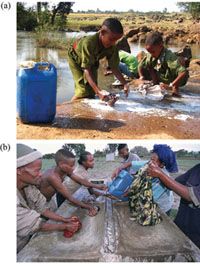3.4.10 Clothes hygiene
We usually have two layers of clothing. The internal layer is underwear (or underclothes) such as pants, vest and T-shirt. These are right next to our skin and collect sweat and dead skin cells, which can stain the cloth. Bacteria love to grow on this dirt and produce a bad smell in addition to the specific odour of the sweat. Underwear must be washed more frequently than the outer layer of clothing.
Clothes hygiene is an important aspect of one’s dignity. Changing used clothes for clean ones every day is recommended. Washing dirty clothes requires adequate clean water, detergents (solid or powdered soap) and washing facilities (Figure 3.7). If possible, the washed clothes should be ironed to help the destruction of body lice and nits. Boiling water or insecticides can be used to destroy clothes infestation.

Frequent changing into clean clothes might not always be possible in poor households. However, the frequency of changing is advised to be twice a week for internal wear and 12 times per week for outerwear. The frequency mainly depends on the intensity of dirt on the clothes, and that depends on the climate and type of activity.
3.4.9 Armpit and bottom hygiene
